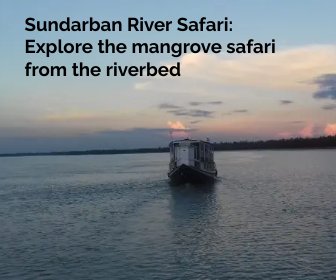Experiencing the Sundarban River Safari adventure is as thrilling as exploring the Mangrove Forest. The delta of Ganges, Padma, and Brahmaputra houses a network of waterways. The canals, rivulets, distributaries, and river confluences are spread in the mangrove area as a network of waterways which has made the Mangrove area widely accessible by waterways. Tidal waterways are the integral part of this Mangrove Forest.
The Riverbeds in Sundarban are quite widespread for their proximal distance from the ocean and due to their confluences. Boating on Sundarban Riverbeds is a unique experience and it is a safer way to view the tiger safari from a distance.
Setting Sail on the Sundarbans River Safari:
Embarking on a Sundarban River Safari is an unparalleled way to explore this ecological wonder. Several tour operators offer meticulously planned itineraries that combine relaxation with adventure, ensuring a seamless journey through the heart of the Sundarban mangrove forests. Boarding a well-equipped vessel, travelers are treated to the unique privilege of witnessing the Sundarbans from a perspective that few have experienced.
As the river cruise sets sail, passengers are greeted by the soothing sounds of water gently lapping against the boat. The air is filled with a mix of salt and earthy aromas, setting the tone for the days ahead. Knowledgeable guides provide an insightful introduction to the Sundarbans, sharing information about the unique ecosystem, the diverse wildlife, and the conservation efforts in place.
The wildlife views

The boat glides through the Sundarban River, and it is easier to watch the intricate network of water channels that crisscross the mangrove forests. Along the riverbanks you mayget a glimpse of spotted deer, crocodiles, and a myriad of bird species, offering a taste of the rich biodiversity that thrives in this enchanting landscape.
The riverbed exploration unveils a world of wonders. The roots of the mangrove trees form a complex labyrinth, creating a natural barrier against erosion and supporting an array of marine life. The mudflats come alive with fiddler crabs, while elusive mudskippers make occasional appearances, showcasing the unique adaptations of creatures that call the Sundarban home.
In a Sundarban River Safari program, the passengers can avail the opportunity to embark on smaller vessels, navigating the narrower waterways that lead to the heart of the mangrove forest. The mangrove safari begins in earnest, with experienced local guides steering the way through dense foliage, providing insights into the intricate ecology of the Sundarbans. The boat safari starts with the high tide as the tidal waterways offer a natural way to reach the intricate part of the forest. Instead of the usual jeep safari, the boat safari adds a charm of wildlife adventure for wildlife enthusiasts.
The Sundarban also hosts a vibrant aquatic ecosystem. Dolphins playfully swim alongside the boat, while saltwater crocodiles bask in the sun, creating a spectacle for wildlife enthusiasts and photographers alike. The cruise itinerary is thoughtfully designed to maximize wildlife sightings, ensuring that each passenger gets a chance to witness the splendor of the Sundarbans’ inhabitants.
Cultural Immersion and Local Communities:
A Sundarban river Safari is not just about nature; it’s also an opportunity to connect with the local communities that inhabit the fringes of this unique ecosystem. The boat docks at traditional fishing villages, providing passengers with a glimpse into the daily lives of the Sundarbans’ resilient residents.
Guests have the chance to interact with locals, learning about their customs, traditional fishing techniques, and the challenges they face in coexisting with the wild. This cultural immersion adds a rich layer to the overall experience, fostering a deeper appreciation for the delicate balance between human communities and the natural world.
A Journey Beyond the Ordinary
A Sundarban River Safari is more than just a vacation; it’s a transformative journey into the heart of one of the world’s most extraordinary ecosystems. Navigating the mangrove safari from the riverbed allows travelers to witness nature’s majesty up close, forging a deep connection with the delicate balance of life that defines the Sundarbans.
As the cruise journey comes to an end, passengers carry with them not just memories of breathtaking landscapes and wildlife encounters but also a renewed sense of responsibility for the conservation of this invaluable natural treasure. The Sundarban, with its unearthly beauty and ecological significance, invites all who venture there to become stewards of its magnificence.
The best time for the Sundarban River Safari program
The best time for the Sundarban River Safari program largely depends on the weather, wildlife sightings, and the overall experience you seek. Here’s a breakdown of the seasons and their impact on the Sundarban River Safari :
Winter (November to February):
- Weather: This period offers pleasant and cooler temperatures, making it a comfortable time for travel. Daytime temperatures range from 10 to 25 degrees Celsius (50 to 77 degrees Fahrenheit).
- Wildlife: The lower temperatures may increase the chances of wildlife sightings, including the elusive Bengal tiger, as they are more active during this time.
Tourist Traffic: Winter is a popular time for tourists, so it’s advisable to plan and book your Sundarban tour well in advance.
Spring (March to April):
- Weather: The temperatures start to rise during spring, with daytime temperatures ranging from 15 to 30 degrees Celsius (59 to 86 degrees Fahrenheit).
- Wildlife: Wildlife sightings are still favorable, and the chances of spotting various bird species increase as migratory birds start to arrive.
Summer (May to June):
- Weather: Summer brings warmer temperatures, with daytime temperatures ranging from 25 to 35 degrees Celsius (77 to 95 degrees Fahrenheit). Humidity levels can be high.
- Wildlife: While wildlife sightings are still possible, the heat may lead to animals seeking shade and being less active during the hotter parts of the day.
Monsoon (July to September):
- Weather: Monsoon season sees heavy rainfall, creating challenging conditions for travel. Daytime temperatures range from 25 to 30 degrees Celsius (77 to 86 degrees Fahrenheit). This is the best time for wildlife enthusiasts who do not prefer crowd and wants to watch the wild version of rivers and tidal waves.
- Wildlife: Wildlife is still present, but dense foliage and rain may reduce visibility.
Post-Monsoon/Early Autumn (October):
- Weather: The post-monsoon period sees a decrease in rainfall, and the weather becomes more comfortable. Daytime temperatures range from 25 to 35 degrees Celsius (77 to 95 degrees Fahrenheit).
However, the winter months of November to February are generally considered the best time for the Sundarban River Safari, offering a balance of comfortable weather, active wildlife, and lush vegetation. However, individual preferences and tolerance for different weather conditions may influence the optimal time for your visit.
Always check with tour operators for the latest information and plan accordingly based on your specific interests and priorities.
How to ensure a seamless experience in Sundarban Boating?
You should book your Sundarban trip with an experienced and tourism department-recognized tour operator like Madhuban Leisure. You may contact the tour operator at call +91 9903977265 / +91 9331055704 and share your plan for the Sundarban visit. Meanwhile, for more info on the Sundarban tour and Sundarban tour attractions and review on Madhuban Leisure Holiday conducted tours, please browse https://www.sundarbantigerroarresort.com




